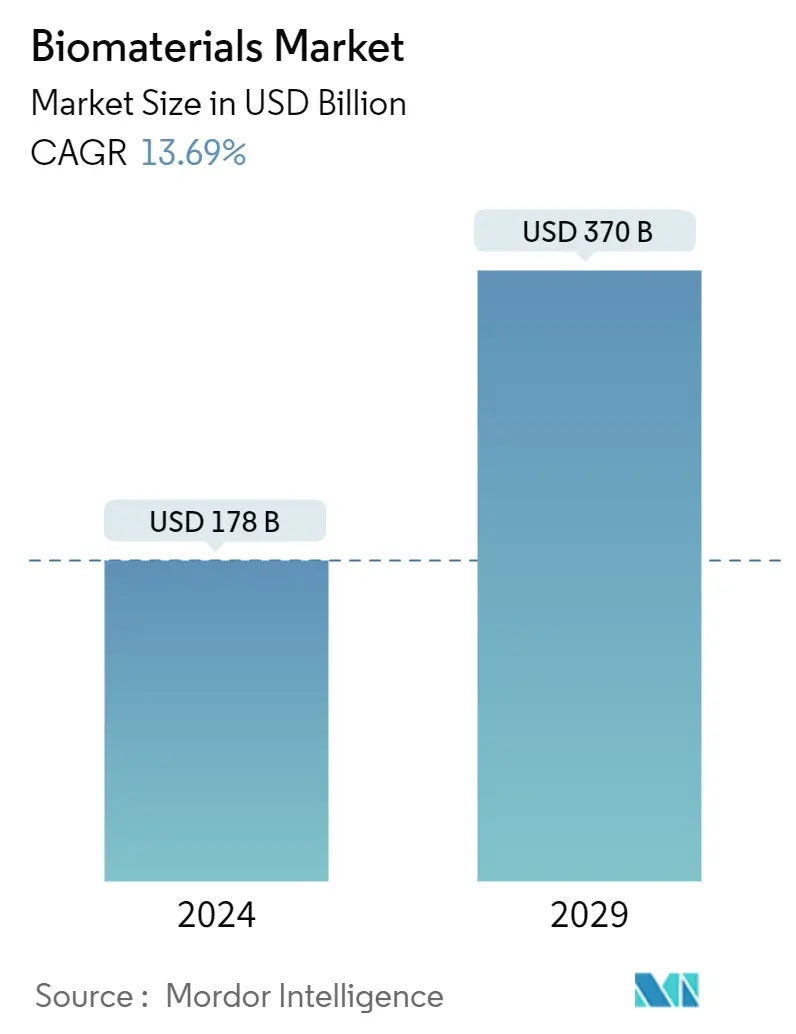Market Size of Biomaterials Industry

| Study Period | 2019 - 2029 |
| Market Size (2024) | USD 178 Billion |
| Market Size (2029) | USD 370 Billion |
| CAGR (2024 - 2029) | 13.69 % |
| Fastest Growing Market | Asia-Pacific |
| Largest Market | North America |
Major Players
*Disclaimer: Major Players sorted in no particular order |
Biomaterials Market Analysis
The Biomaterials Market size is estimated at USD 178 billion in 2024, and is expected to reach USD 370 billion by 2029, growing at a CAGR of 13.69% during the forecast period (2024-2029).
The biomaterials market is poised to register a CAGR of 13.69% over the forecast period.
The COVID-19 pandemic had a significant impact on the market. The decline in non-emergency surgical procedures declined the demand for biomaterials during the pandemic. For instance, in April 2022, Nova Scotia's QEII Health Sciences Centre decided to postpone most non-urgent and elective surgeries due to the increasing number of patients with COVID-19 in the hospital.
As a result, the demand for biomaterials declined during the pandemic. However, the development of various biomaterials and biomedical devices is in demand for detecting and treating coronaviruses and is expected to rise over the forecast period.
In wound care, biomaterials are used to develop advanced dressings, scaffolds, and skin substitutes that enhance wound healing and minimize the risk of infections. They provide a conducive environment for tissue regeneration and promote faster healing. According to an article published by the Taylor & Francis Journal1 in June 2022, various biomaterials, including hydrogels, nanofibrous, composite, foam, spongy, bilayered, and trilayered scaffolds are being developed and fabricated to speed up the healing of chronic wounds. Therefore, the surging adoption of biomaterials for developing various wound healing products will burgeon market growth during the forecast period.
In addition, the rising number of wound injuries coupled with the high prevalence of diabetes is projected to drive market growth during the upcoming period. For instance, as per the data released by the International Diabetes Federation (IDF) in November 2022, approximately 537 million adults worldwide were living with diabetes in 2021. The number is projected to increase to 643 million by 2030 and 783 million by 2045. Therefore, the surging number of diabetic people is leading to growth in the number of wound injuries, thereby augmenting the growth of the biomaterials market.
Furthermore, the increasing number of multiple fractures and several injuries will likely drive market growth during the upcoming period. For instance, as per the data published by the CDC in May 2023, around 300,000 older people are hospitalized annually for hip fractures in the United States. According to the same source, approximately 3 million elderly people are treated in emergency departments for fall injuries every year. Therefore, the rising number of injuries is projected to drive the demand for biomaterials to develop medical implants.
The rising number of car accidents is also associated with traumatic fractures. For instance, according to the data published by Destatis in January 2023, it is estimated that over 29,000 people were injured in traffic accidents in Germany in November 2022. It has also been reported that this number increased by just under 2,400, or 9%, compared with the same month a year earlier, November 2021.
Thus, the factors above are expected to boost market growth over the forecast period. However, compatibility issues and stringent guidelines restrain the market's growth.
Biomaterials Industry Segmentation
As per the scope of the report, biomaterials are substances that have been engineered to interact with biological systems for a medical purpose, either a therapeutic (treat, augment, repair, or replace a tissue function of the body) or a diagnostic one.
The biomaterials market is segmented by type of biomaterial (natural biomaterial, metallic biomaterial, ceramic biomaterial, and polymeric biomaterial), application (neurology, cardiology, orthopedics, ophthalmology, wound care, dental, plastic surgery, and other applications), and geography (North America, Europe, South America, Asia-Pacific and the Middle East and Africa). The market report also covers the estimated market sizes and trends for 17 different countries across major regions globally.
The report offers the value (USD) for all the above segments.
| By Type of Biomaterial | |
| Natural Biomaterial | |
| Metallic Biomaterial | |
| Ceramic Biomaterial | |
| Polymeric Biomaterial |
| By Application | |
| Neurology | |
| Cardiology | |
| Orthopedics | |
| Ophthalmology | |
| Wound Care | |
| Dental | |
| Plastic Surgery | |
| Other Applications |
| Geography | ||||||||
| ||||||||
| ||||||||
| ||||||||
| ||||||||
|
Biomaterials Market Size Summary
The biomaterials market is experiencing significant growth, driven by advancements in medical and dental applications. The market is expected to expand substantially over the forecast period, fueled by the increasing adoption of biomaterials in wound care, medical implants, and dental applications. The demand for biomaterials is being propelled by the rising prevalence of chronic wounds, diabetes-related injuries, and dental diseases worldwide. Innovations in biomaterial technologies, such as hydrogels and scaffolds, are enhancing wound healing and tissue regeneration, while the growing need for dental implants due to untreated dental caries is further boosting market expansion. Despite the challenges posed by the COVID-19 pandemic, which temporarily reduced demand in non-emergency surgical procedures, the market is poised for recovery and growth, supported by the development of biomaterials for medical devices aimed at detecting and treating viruses.
Regionally, North America is anticipated to hold a significant share of the global biomaterials market, driven by a large target population, high adoption of advanced medical technologies, and a robust presence of pharmaceutical companies. The increasing prevalence of arthritis and sports-related injuries in the United States is expected to further drive demand for biomaterials. Additionally, the rise of Ambulatory Surgical Centers (ASCs) offering minimally invasive procedures presents opportunities for biomaterial manufacturers to cater to specific needs. Technological advancements, such as the development of synthetic biomaterials like PEEK, are also contributing to market growth. The competitive landscape is moderately active, with major players and emerging companies vying for market share, particularly in emerging economies. Recent product launches and regulatory approvals in the dental sector highlight ongoing innovation and expansion opportunities within the market.
Biomaterials Market Size - Table of Contents
-
1. MARKET DYNAMICS
-
1.1 Market Overview
-
1.2 Market Drivers
-
1.2.1 New Innovations in the Field of Biomaterials
-
1.2.2 Increasing Implant Devices and Plastic Surgery Market
-
1.2.3 Increasing Applications of Biomaterials in Wound Care/Sports Injury
-
-
1.3 Market Restraints
-
1.3.1 Compatibility Issues
-
1.3.2 Stringent Regulatory Guidelines
-
1.3.3 High Price of the Implantable Biomaterials
-
-
1.4 Porter's Five Forces Analysis
-
1.4.1 Threat of New Entrants
-
1.4.2 Bargaining Power of Buyers/Consumers
-
1.4.3 Bargaining Power of Suppliers
-
1.4.4 Threat of Substitute Products
-
1.4.5 Intensity of Competitive Rivalry
-
-
-
2. MARKET SEGMENTATION (Market Size by Value USD million)
-
2.1 By Type of Biomaterial
-
2.1.1 Natural Biomaterial
-
2.1.2 Metallic Biomaterial
-
2.1.3 Ceramic Biomaterial
-
2.1.4 Polymeric Biomaterial
-
-
2.2 By Application
-
2.2.1 Neurology
-
2.2.2 Cardiology
-
2.2.3 Orthopedics
-
2.2.4 Ophthalmology
-
2.2.5 Wound Care
-
2.2.6 Dental
-
2.2.7 Plastic Surgery
-
2.2.8 Other Applications
-
-
2.3 Geography
-
2.3.1 North America
-
2.3.1.1 United States
-
2.3.1.2 Canada
-
2.3.1.3 Mexico
-
-
2.3.2 Europe
-
2.3.2.1 Germany
-
2.3.2.2 United Kingdom
-
2.3.2.3 France
-
2.3.2.4 Italy
-
2.3.2.5 Spain
-
2.3.2.6 Rest of Europe
-
-
2.3.3 Asia-Pacific
-
2.3.3.1 China
-
2.3.3.2 Japan
-
2.3.3.3 India
-
2.3.3.4 Australia
-
2.3.3.5 South Korea
-
2.3.3.6 Rest of Asia-Pacific
-
-
2.3.4 Middle East and Africa
-
2.3.4.1 GCC
-
2.3.4.2 South Africa
-
2.3.4.3 Rest of Middle East and Africa
-
-
2.3.5 South America
-
2.3.5.1 Brazil
-
2.3.5.2 Argentina
-
2.3.5.3 Rest of South America
-
-
-
Biomaterials Market Size FAQs
How big is the Biomaterials Market?
The Biomaterials Market size is expected to reach USD 178 billion in 2024 and grow at a CAGR of 13.69% to reach USD 370 billion by 2029.
What is the current Biomaterials Market size?
In 2024, the Biomaterials Market size is expected to reach USD 178 billion.

